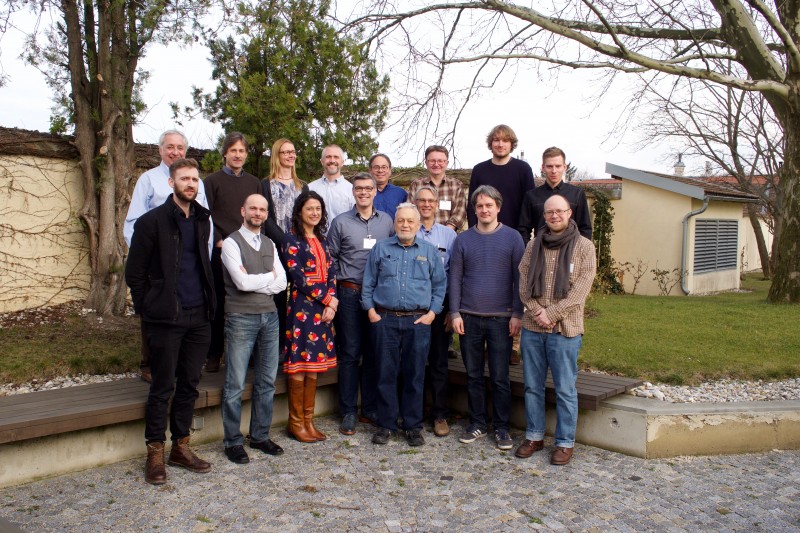News Details

In March 2018, Daniel (Dan) Brooks, James DiFrisco, and William (Bill) Wimsatt co-organized the 36th Altenberg Workshop in Theoretical Biology on Hierarchy and Levels of Organization in the Biological Sciences. We're excited to see that the work developed in the workshop has now been published as a new volume in the Vienna Series in Theoretical Biology of the MIT Press- Levels of Organization in the Biological Sciences.
Dan and James explain how they put together the workshop and the book.
Q: What was the motivation for putting together the workshop? What kinds of issues did you address?
A: Planning for the workshop began over a coffee at the ISHPSSB 2015 in Montreal. We approached Bill between sessions and asked if he’d like to discuss his work on levels and complexity in biology. During that wonderful conversation, there emerged a strong collective perception of an acute lacuna existing in the philosophical and theoretical biological literature on the topic of levels of organization.

Bill Wimsatt (right)
Accordingly, one of the main motivations for the workshop was to address this lacuna by constructing a small community of dedicated commentators who had contributed to a set of issues we viewed as germane to further developing the concept of levels in biological science. One important touchstone for our thinking here was Bill’s work on the topic, which has been centrally featured in his work on evolution, complexity, and scientific reasoning. In particular, his 1994 paper “The Ontology of Complex Systems,” revised and reprinted in his 2007 book, is arguably a modern classic, yet in our view is only sparingly engaged with in detail. Bill’s paper thus became a kind of core motif in our thinking concerning how to organize the meeting. These original inspirations were etched into our book’s cover and opening pages, where we displayed Bill’s “local maxima” depiction of levels as peaks and valleys between local maxima and minima of regularities and predictability (this image originally appeared in Bill’s 1976 paper on levels).
The goal since the beginning of our planning was certainly to publish the dialogues that emerged from the workshop in a form that would create a novel and roughly unified collection of forward-looking ideas on levels.
Q: What was the workshop like? Do you have any interesting conversations or highlights you'd like to share from the workshop?
A: The workshop was a resounding success, one of the best academic events either of us has participated in. We proceeded by structuring the talks around thematic blocks to create a natural dialogue between the participants. In this way, the discussions flowed, e.g., from initial statements about how levels could be conceptualized and why the concept is such a central notion in biological reasoning, to critical talks questioning the legitimacy of the concept and highlighting the challenges of engaging with the topic of levels, to finally more specialized work linking to particular issues such as the use of levels in scientific practice, the origin of new levels, downward causation, and the relationship between levels and natural kinds. (Editor: you can download the conference program here)

Workshop participants
Q: How did you structure the book? How are the chapters tied together?
A: Each contributor of the book Levels of Organiation in the Biological Sciences was specifically invited to contribute a detailed analysis on a topic or issue connected to levels that we felt were apropos of the scope of our central themes. At the same time, however, we decided against separating the book into distinct sections, as we felt this would have detracted from the flow of conversation that emerged at the workshop. In our introductory essay “Levels of Organization: The Architecture of the Scientific Image,” we actually lay out what we perceive to be key ideas that recur and build upon one another throughout the volume. This “unified front,” as we call it, includes particularly new thinking on so-called ‘downward’ causation, dynamical autonomy, and compositionality in complex biological systems.
Levels of Organization in the Biological Sciences (MIT Press) with Table of Contents (also right click image to download)
Q: Did anything else come out of the workshop? Do you have future plans to follow up with another event or collection?
A: The workshop and the levels volume were in fact only the beginning to wider research programs that each of us now pursue. For instance, Dan’s current DFG-funded position at the Ruhr-University of Bochum built upon our efforts to construct a multi-year project aimed at collating and concretizing the new research avenues on the levels concept provoked by our volume. For this, the workshop and Altenberg volume have proven invaluable sources that have opened networks, conversation partners, and of course laid down new and primary research. The goal of his project is to produce a systematic monograph documenting and analyzing the history, philosophy, and theoretical biology of levels in scientific reasoning since the early 20th century. Its tentative title is The Leveled World: The Role of Levels of Organization in Biological Thought.
Thank you for accepting this interview, Dan and James. We look forward to hearing more from you about your current projects!


